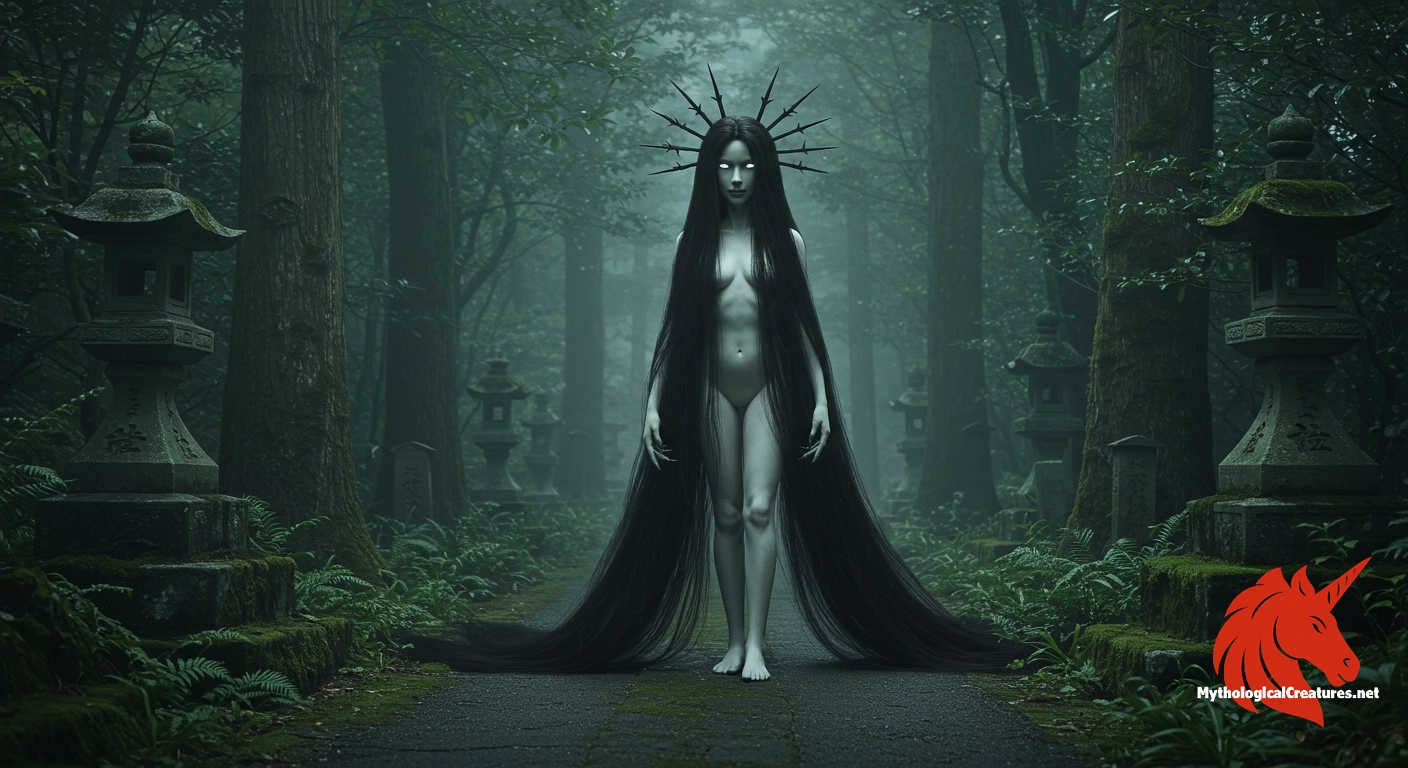Harionago: Harionago, the Barbed Woman, is a malevolent female ghoul from Japanese mythology known for her long, thorn-tipped hair.

Harionago
Harionago - Serves as a cautionary tale about deceptive beauty and the dangers of succumbing to allure.
Origins & First Encounters
Harionago is a striking and enigmatic figure whose legend has been woven into the rich tapestry of Japanese myth. She is portrayed as a beautiful yet fearsome female spirit whose curse transforms her into an agent of retribution and seduction. Emerging from an era when oral recitations and local superstitions dominated, her narrative reflects the delicate balance between allure and peril. Many traditions hint that her transformation was born of profound anguish and betrayal, which has rendered her both tragic and terrifying. The creature’s early attestations are wrapped in layers of folklore, depicting her both as a warning and as an intriguing supernatural mystery. Her presence in myth serves as an enduring reminder of the complex interplay between beauty and danger inherent in the spirit world. The legend of Harionago is deeply embedded in the cultural context of rural Japan, where the natural and supernatural worlds intertwine. Over the centuries, this ghastly figure has evolved from a whispered caution along lonely roads to a potent symbol of the dark side of feminine power and seduction.
Source Texts & Tale Variants
The narrative of Harionago is found in various traditional accounts and forms part of a broader compendium of Japanese supernatural lore. Oral tales, passed down through generations in the regional communities of Ehime, have played a pivotal role in sustaining her enigmatic presence. Written records from the Edo period and later compilations of yōkai stories occasionally allude to her malevolent exploits and tragic beauty. Diverse story variants stress differing details of her narrative, with some focusing on her cursed origins and others on the haunting consequence of her interactions with unwary men. Local guidebooks and folk compilations have contributed to the fragmentation and enrichment of her myth. Though not as formally documented as some other spectres, her legend has been maintained by storytellers eager to caution against the allure of unknown forces. The retelling of her tale in various texts illustrates the versatility of Japanese myth, where supernatural beings are reinterpreted based on regional sensibilities. These story fragments, while varied, converge on the idea of a deadly enchantress whose beguiling smile belies a hidden terror. As such, her myth thrives in both written and oral traditions, manifesting in different forms across time.
Form & Powers
Visually, Harionago is depicted with a startling beauty that belies her dangerous nature. Her most distinctive feature is her extraordinarily long hair, which is uniquely adorned with sharp, thorn-like tips that glint with a menacing allure. Every strand of her hair appears to have a life of its own, seemingly controlled by her will to capture and harm her target. Her face, often described as exquisitely beautiful, is also touched by sorrow and malice, creating an arresting juxtaposition. The traditional imagery captures her with impeccably pale, almost luminescent skin that heightens the eerie quality of her presence. Artists have rendered her wearing elegant, flowing garments that further enhance her otherworldly beauty while contrasting with the chaotic danger her hair represents. Variations in portrayals sometimes show her as a spectral figure with an ethereal glow, emphasising her transformation from mortal woman to vengeful spirit. Her physicality, combining both grace and menace, has made her a timeless icon in the visual lexicon of Japanese ghost stories. Each detailed aspect of her anatomy, from her lethal hair to her sorrowful eyes, contributes to the chilling allure that defines her legend.
Regional Faces
While the core elements of Harionago’s legend remain rooted in the mythos of Ehime, regional interpretations have introduced subtle variations in her character and symbolism. In some local traditions beyond Ehime, aspects of her story merge with broader regional narratives of vengeful spirits, lending her added layers of complexity. Certain communities have reinterpreted her legend to include elements of tragic romance, where her curse is seen as the result of personal loss or betrayal. In contrast, other areas emphasise her as a straightforward harbinger of doom who preys on the unwary. Local aesthetics influence depictions of her, sometimes altering the vividness of her hair or the style of her traditional attire to better suit the cultural milieu. Rural variations have occasionally portrayed her as both a punitive figure and a reminder of the consequences of breaking social taboos. In urban retellings, her myth is often repackaged into modern media where her dangerous allure is both celebrated and feared. The regional multiplicity in her narrative underlines the adaptability of myth, as storytellers reshape her attributes to reflect local values and historical experiences. This diversity ensures that Harionago remains a dynamic and compelling figure across different parts of Japan.
Cultural Parallels
The striking duality of beauty and danger that defines Harionago resonates with similar mythological figures from other cultures. There are echoes of the Greek sirens in her seductive method of luring victims, as well as parallels with other monstrous figures who wield beauty as both an asset and a weapon. Like some of the legendary femme fatales found in various mythologies, her narrative challenges conventional expectations by blending irresistible charm with lethal intent. The motif of a dangerously attractive woman is a recurring archetype that serves as a cautionary tale in many cultural narratives. Comparisons can also be drawn with the vampiric legends of Eastern Europe, where allure is often the veneer masking a deadly nature. In both Western and Eastern traditions, such figures provoke reflection on the risks associated with superficial judgements based solely on beauty. Despite the cultural variations, the underlying themes of retribution, seduction, and the inversion of conventional femininity are remarkably consistent. Harionago’s embodiment of these themes places her amongst a global roster of mythological beings that straddle the boundaries of beauty and horror. This comparative insight highlights how the interplay between attractiveness and malevolence is a universal concept in myth, transcending geographical boundaries.
Legacy & Modern Evolution
The story of Harionago has evolved significantly over time, reflecting both shifts in cultural sensibilities and the influence of modern media. Her origins in traditional folklore have expanded to include layers of narrative complexity that resonate with contemporary audiences. Initially a cautionary tale woven into the fabric of rural superstition, her legend has now found a place in graphic literature, film, and digital media. Modern interpretations often highlight her character as a metaphor for the hidden dangers behind enticing facades in both a literal and symbolic context. Artistic renditions have oscillated between romanticising her tragic past and portraying her as a formidable antagonist in horror genres. The dynamic reinterpretations that have emerged over time showcase how traditional myth can be reimagined to reflect modern concerns about identity and societal expectations. In academic discussions as well as popular culture, her image is used to explore themes of power, transformation, and the inversion of typical gender roles. The enduring legacy of Harionago is a testament to the timeless appeal of mythic archetypes, where beauty is entwined with peril. Today, she stands as both a symbol of ancient superstitions and a versatile character adapted for a rapidly changing cultural landscape.
Interesting Fact
An intriguing aspect of Harionago is her ability to transform a symbol of beauty—long, flowing hair—into a deadly weapon, challenging conventional notions of attractiveness in folklore.
Quick Creature Info
Features:
Associations:
Our Mythic Legendary Rating:

Also Sometimes Known As:
Habitat:
Supernatural Powers:
Physical Attributes:
Abilities:
Behavior:
Lore:
Related Creatures, Tales or Lore
References
Discover Another Mythical Legend You May Not Have Heard Of?
Uncover the mysteries of ancient folklore and expand your knowledge of legendary beings from cultures around the world.
Dare to Meet the Wangpulen....
Mythical Disclaimer: The images and data on this site are derived from various historical and literary sources, but we have found that many myths often have multiple versions and interpretations across references, sometimes contradictory. As a result, these creature depictions are artistic interpretations—imaginative blends of folklore, legend, and a dash of AI guesswork. Because creature descriptions vary widely, our illustrations and accompanying information represent our best effort to honor mythology while bridging creative gaps. Enjoy these interpretations—just remember, we've done our best to respect the stories and validate available data, but in the realm of mythology, details often shift, imagination leads the way, and nothing is ever set in stone!
Curated by the Mythological Creatures Team (rev. May 2025)
